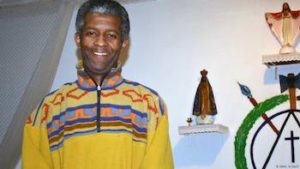
*Afro Uruguayans, Uruguayans of African descent, were celebrated on this date in 1500. For most of the colonial period, the port of Buenos Aires (see Afro Argentines) served as the exclusive entry point for the middle passage in the Río de la Plata region.
Slaves entering the port of Buenos Aires were then regularly shipped inland to Córdoba and the northwestern provinces of Salta and Tucumán in Argentina, across the Andes Mountains to Chile (see Afro Chileans), and to the mines of Potosí in Alto Perú (see Afro Bolivians). Uruguay has a complex history of militias and military action. Colonial militia service went hand in hand with slave enrollment during wars of independence. These militias, specifically the colonial Black militias centered in the Rio de la Plata, had opened themselves to the idea of taking in slaves to strengthen their military, meaning both free and enslaved men of African descent fought together in battles after 1810.
The gain of slaves allowed the addition of people, mixing races, ideals, and class levels. Black recruits within the militia had mixed thoughts on the military, some soldiers seeing the military as a burden versus black officers seeing potential in the militias. The recruits taken in, in the form of slaves, provided more soldiers that would be fighting for Uruguay on foot. The slaves involved in these militias, also called “citizen-soldiers,” were able to defend their rights and gain some freedom through their service. This new form of freedom allowed enslaved and free men to create black communities, where soldiers would create identities and be one with society. Slave ships bringing over soldiers brewed collected identities to interact with one another and create social networks.
These networks allowed Africans and their descendants to push against domination within the Spanish Regime. All men strong enough and of African descent were impacted by the military regardless of whether they were already in a battalion or an emerging battalion. Free nonwhites were forced to serve along with white men before 1841. Even with the pressure of the military, some Africans willingly joined militias before slavery was abolished. Black communities in these Militias gave Africans a sense of belonging and helped them enter the Republic of Uruguay’s colonial societies. Until 1830, black soldiers were responsible for establishing and creating the first professional Uruguayan infantry, followed by all African men of ancestry being added into the army of Guerra Grande from 1839 to 1852 and freed.
With the freedom of slaves, unlike before, when white officers commanded black soldiers, anyone from black battalions could now participate in military networks. Black militia officers gained legal privileges and contributed to national politics because of the ban on slavery. Along with the anti-slavery laws set in Uruguay, any newly arrived slaves would be freed and be reintroduced as “African colonists.” As recruits of Black soldiers flowed in, the freed individuals could connect more with commanders and people in units and create social strategies in these new formations. The building of Uruguay and its success hinged on its military, the black militias, and their actions based on African-born populations in the second half of the 18th Century after the abolishment of slavery in1842, a war in the Río de la Plata deployed free Black militias. These militias were spread from Paraguay to Montevideo, and African troops were ordered to march beside the Spanish to fight the Guaraní missions on the Uruguay River. Over this mass of land, the black populations made contact and created bonds with the militias.
These interactions allowed more men to join and prolong the development of these associations. African influence in the military was vast, and the militias took in these traditions to celebrate and honor African culture. The Day of Kings was a celebration portrayed by Africans and was heavily influenced by the Catholic religion and how it was mixed with African ideals. African traditions were incorporated into the Military uniforms and flag of Uruguay to capture the sense of community and culture. This furthered the sense of belonging in these militias, where African battalions could highlight their military role in the nation's founding.
Candombe's origins lie in the "Kings of Congo" ceremonial processions from the period of African slavery in South America. Candombe is related to other musical forms of African origin found in the Americas, such as Cuban son and Tumba and Brazilian maracatu and congadas. The form evolved at the beginning of the 19th Century. Most Afro-Uruguayans are in Montevideo. In the 21st Century, some Nigerians, Cameroonians, Senegalese, and other African immigrants exist.
The term “Afro Uruguayans” is difficult; it can diminish relations of these individuals in black communities and is much too specific because of mixed cultures. To strengthen the connections between black communities in the 1800s, “Orientals” is more fitting regarding modern-day Uruguay rather than “Afro-Uruguayans” because of the land's history and origin. There is an Afro-Uruguayan trend within the country’s feminist movement.